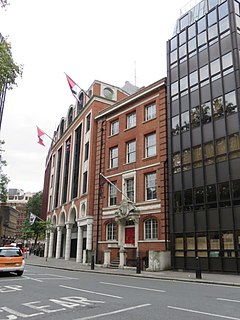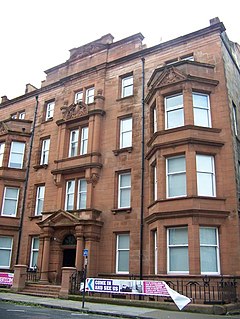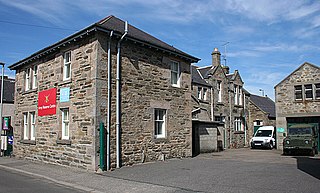
The Gordon Highlanders was a line infantry regiment of the British Army that existed for 113 years, from 1881 until 1994, when it was amalgamated with the Queen's Own Highlanders to form the Highlanders. Although the 'Gordon Highlanders' had existed as the 92nd Regiment of Foot since 1794, the actual 'Gordon Highlanders Regiment' was formed in 1881 by amalgamation of the 75th (Stirlingshire) Regiment of Foot and 92nd Regiment of Foot.

The 51st Highland Volunteers is a battalion in the British Army's Army Reserve or reserve force in the Scottish Highlands, forming the 7th Battalion of the Royal Regiment of Scotland, also known as 7 SCOTS. It is one of two Reserve battalions in the Royal Regiment of Scotland, along with 52nd Lowland, a similar unit located in the Scottish Lowlands.

The Buckingham Gate drill halls were military installations at 58 and 59 Buckingham Gate, London.

The Haldane Building is a former drill hall at Hill Street in Garnethill, Glasgow.

Hepburn House, also known as East Claremont Street Drill Hall, is a military installation in Edinburgh.

The West Princes Street drill hall is a former military installation in Glasgow, Scotland.

The Titchfield Street drill hall is a former military installation in Kilmarnock.

The Paton Street drill hall is a military installation in Galashiels, Scotland.

The Bank Street drill hall is a former military installation in Brechin, Scotland.

The Perth Road drill hall is a former military installation on Perth Road in Birnam, Perth and Kinross, Scotland.

The Hunter Street drill hall is a military installation in Kirkcaldy, Scotland.

The Ferry Road drill hall, known locally as Seaforth Barracks, is a military installation in Dingwall, Scotland.

The Old Bank Road drill hall is a military installation in Golspie, Scotland.

The Cooper Park drill hall is a former military installation in Elgin, Scotland.

The Union Street drill hall is a military installation in Keith, Scotland.

The Kinneskie Road drill hall is a former military installation near Banchory, Scotland.

The Rose Street drill hall is a former military installation in Inverness, Scotland.

The High Street drill hall is a former military installation in Paisley, Scotland.

The Princes Street drill hall is a former military installation in Stirling, Scotland.

Hartfield House is a military installation in Dumbarton, Scotland.





















